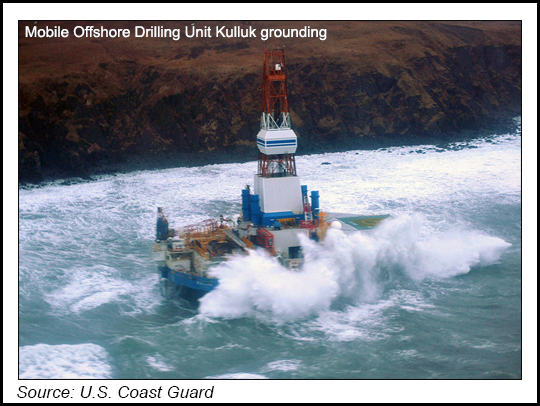Regulatory | NGI All News Access
USCG: Bad Planning Led to Shell Rig’s Alaska Grounding in 2012
The grounding of Royal Dutch Shell plc’s Mobile Offshore Drilling Unit Kulluk on the eastern coast of Sitkalidak Island, Alaska, in late December 2012 was mainly due to a failure of personnel to assess and manage the risks of towing the rig in heavy seas, the U.S. Coast Guard (USCG) said in a report on the incident issued Thursday.

The report suggests that Shell should face legal penalties for the incident. It comes 10 months after a USCG hearing in Anchorage. The company acknowledged the report and said it was being reviewed.
“…[T]he inadequate assessment and management of risks by the parties involved was the most significant causal factor in the mishap,” said USCG Rear Adm. Joseph Servidio in comments accompanying the 152-page report.
“I am most troubled by the significant number and nature of the potential violations of law and regulations identified in the enforcement section of the investigative report, including the failure to report marine casualties, failure to report safety-related vessel issues, and improper/illegal bridge and engine room watch-keeping systems…I am additionally troubled by the potential evidence of negligent conduct by master, chief engineer, and third mate aboard the anchor-handling Offshore Supply Vessel M/V Aiviq…”
The unit was owned by Shell Offshore Inc.; its operator was Noble Drilling (US) LLC. Shell personnel were in charge of developing and carrying out the tow plan for the vessel. Kulluk was being moved from Alaska to Seattle, in part to avoid payment of millions of dollars of state taxes, according to the USCG report, when it broke loose from its tow vessel and ran aground on New Year’s Eve 2012 (see Daily GPI, Jan. 3, 2013). The rig was refloated and moved to safety days later in an effort that involved more than 730 people (see Daily GPI, Jan. 8, 2013). There were no reports of significant pollution or injuries.
“Already, we have implemented lessons learned from our internal review of our 2012 operations,” Shell said in response to the report. “Those improvements will be measured against the findings in the USCG report as well as recommendations from the U.S. Department of Interior.”
The vessel Aiviq was purpose built to support the operations of Kulluk. The towing trip was plagued by bad weather, mechanical and other difficulties. The Aiviq master and tow master were concerned about forecasted weather on Dec. 22 and informed the Shell marine manager, requesting a course change, according to the report.
“Their request for a change in course was not formally granted, even though the Shell Tow Plan gave the Aiviq master and tow master the discretion to make course changes and alterations based on certain considerations,” the report said.
Aiviq experienced an oil leak in one of its engines on Dec. 25; on Dec. 27 a towing winch began setting off numerous alarms indicating high tension on the tow line. There were other difficulties with the towing gear. The Shell Tow Plan called for an emergency tow line to be in place aboard Kulluk, but it could not be attached using onboard cranes due to the “motion characteristics” of Kulluk at the time.
Later on Dec. 27, Aiviq “experienced the first in a series of serious engine casualties…” On Dec. 28 the USCG Alex Haley arrived and attempted to establish a tow connection with Kulluk, which failed due a fouling of a propeller by the would-be tow line. Meanwhile, Aiviq engineers were making repairs to their ship’s main engines.
Then the tug Guardsman arrived and attempted to tow both Kulluk and Aiviq, which failed. A helicopter rescue of Kulluk crew was then discussed. The nighttime rescue idea was abandoned as too dangerous. “Pilots reported that the Kulluk was rising and falling approximately 50 feet during these attempts,” the report said.
More trouble ensued, but on Dec. 29 and 30 Kulluk was under tow by Aiviq and another vessel, Nanuq. However, Kulluk again went adrift about 30 miles from land and shoal water. The Kulluk eventually was brought under tow by another vessel, the tug Alert, but that tow was ultimately released due to safety concerns and Kulluk eventually grounded on a stretch of shoreline near Oceans Bay, AK.
The Kulluk report recommends, among other things, establishment of a group to examine issues related to the towing of mobile drilling units in the arctic environment. It also recommends that USCG evaluate the towing equipment aboard its medium- and high-endurance cutter and icebreaker fleet.
Further, the report said, “Shell and any corporation or entity intending to work in the arctic marine environment [should] develop and maintain policies and guidance that addresses all aspects of marine operations to include tow planning for operations across the globe, and establish additional criteria for operations that take place in areas of historical heavy weather, such as the Alaskan theatre.”
The grounding of Kulluk and other incidents drew the attention of the U.S. Department of Interior to Shell’s Alaska drilling program (see Daily GPI, March 18; 2013; Jan. 11, 2013). Shell has said it would not be restarting its Arctic drilling program this year.
“This report shows that Shell ran through every single safety and common sense red light in moving this rig because of financial considerations,” said U.S. Sen. Ed Markey (D-MA), who is a member of the Senate Commerce and Environment committees. “This kind of behavior should raise major red flags for any future Arctic drilling plans. Shell should be held accountable for its reckless behavior.”
© 2024 Natural Gas Intelligence. All rights reserved.
ISSN © 1532-1231 | ISSN © 2577-9877 |
